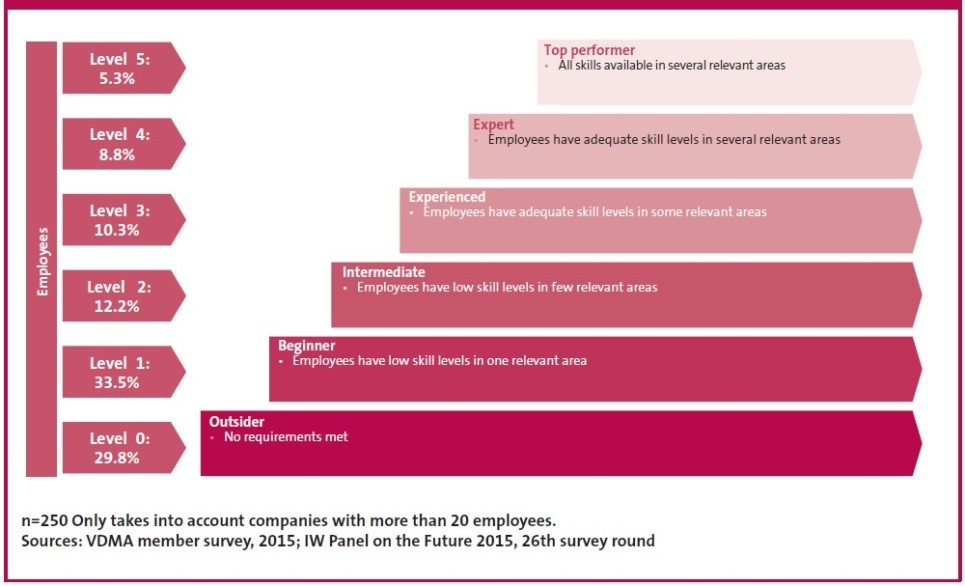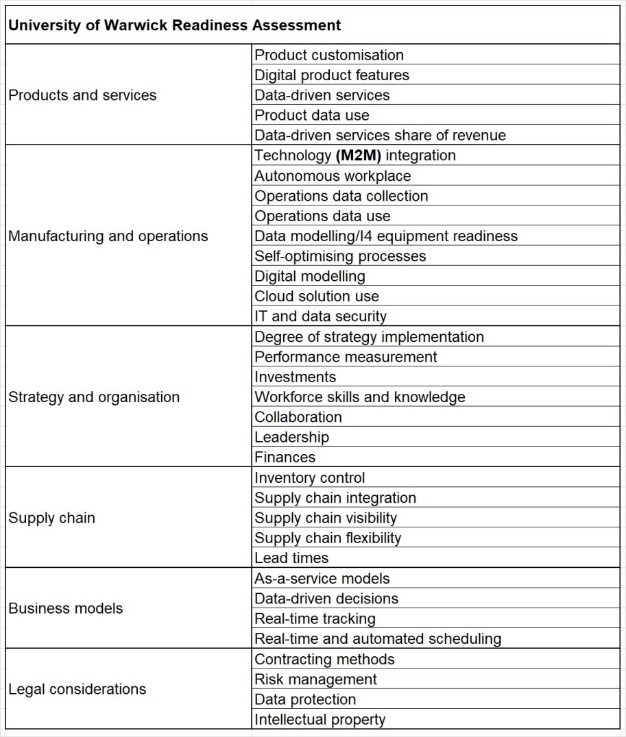Colin's Desk Part 9: Assessing Industry 4.0 Readiness
What is a Readiness Assessment?
In old-fashioned project management terms, a readiness assessment is a pre-project review. With it, you measure your organisation's ability to begin a project and identify areas that need more attention before the project commences. Much of the usefulness of an Industry 4.0 readiness assessment is represented by what seems like a simple question: Is your manufacturing business ready to generate business value by using Industry 4.0 technologies and practices?
By comparing manufacturing capabilities, resources, and experience against a set of industry-wide benchmark values, a manufacturing business can use assessment results to create a roadmap. With this guidance, high-level business goals, and performance standards (KPIs), manufacturers can identify and prioritise Industry 4.0 investments and development.
An Industry 4.0 readiness assessment describes the preparedness of a company to undergo a significant change or take on new capabilities, products, or business models. It’s also an audit process, which uses checklists of resources and capabilities. Assessment criteria are based on the current situation at a manufacturing company. For example, an important indicator of Industry 4.0 development success is a company’s willingness to alter its current manufacturing, business, and training practices. By enforcing a first-things-first approach to Industry 4.0 development, assessment results become a useful tool that can be checked and rechecked as Industry 4.0 investments change and grow. Readiness assessments enforce other helpful disciplines. Measuring company capabilities throughout the supply chain and product life cycle makes it easier for process engineers and business leaders to identify and respond to changes. As they are provided a big picture perspective of their operations and business practices.
Below are three examples of Industry 4.0 readiness assessment framework:
IMPULS Industry 4.0 Readiness Assessment
In 2015, project partners from the Cologne Institute for Economic Research and the Institute for Industrial Management at Aachen University in Germany developed an online tool. With it, interested manufacturing and engineering companies could measure their own individual Industry 4.0 readiness. The study that created the assessment was designed to bring the grand vision of Industry 4.0 down to earth. Then as now, there was a need to bridge Industry 4.0 vision and day-to-day business reality.
The study authors knew that a useful assessment should:
• Highlight the obstacles and challenges that manufacturers must face during their digital manufacturing development efforts.
• Document the resources and capabilities of mechanical and plant engineering companies before Industry 4.0 development begins.
• Focus on what motivates engineers to change their practices and what holds them back.
• Highlight the different assessment results that occur at SMEs and larger companies
• Provide engineers and manufacturers with a detailed, systematic framework of Industry 4.0 concepts, capabilities, and maturity criteria.
The Industrie 4.0 Readiness tool enables users to measure the maturity of their information and operations technology as well as their management and business practices. The framework arranges these sub-dimensions along a spectrum of capabilities, which measure a company’s technology and business maturity. Figure 1 is an example taken from the Employees dimension of the Industrie 4.0 Readiness study:

The figure above provides actual survey results of the 2015 study as well as detailed criteria for each level in the study’s Employees dimension. The percentages of survey respondents that operate at various readiness levels are indicated in the chevrons at the left side of the image.
Warwick University Readiness Assessment
The Warwick Manufacturing Group (WMG) is a department of the University of Warwick in the United Kingdom. In 2017, WMG students and faculty joined forces with global management company, Crimson & Co, and international law firm, Pinsent Masons. The group’s Industry 4.0 readiness assessment was a product of this collaboration. By working with industry and private sector partners, WMG team members added academic discipline to the identification, and possible solution, of a complex business problem — describing the Industry 4.0 readiness of UK manufacturers.
Similar to the Industrie 4.0 Readiness study, the WMG assessment process reviewed the capabilities that enable manufacturers to generate value via Industry 4.0 technologies, ideas, and methods. Like the German study, the UK authors used gap analysis and an Industry 4.0 maturity framework to help businesses identify their progress and needed improvements. In both cases, a survey-based study provided the data needed to build a self-assessment tool.
Major concepts and their relationships — Unlike the Industrie 4.0 readiness study, the WMG team created a model that emphasised supply chain strategy as a driver of business transformation. This approach led to a framework of six dimensions and 34 sub-dimensions, which the study calls fields. Table 1 presents the framework and its topics in tabular form.

Singapore Smart Industry Readiness Index (SIRI)
Launched in November 2017, the Singapore Smart Industry Readiness Index (SIRI) is the result of collaboration between national government agencies and members of the private sector. The country’s Economic Development Board appointed TÜV SÜD, an inspection, certification, and training company, to work with them to develop a comprehensive but easy-to-use self-assessment tool. The SIRI tool is designed especially for manufacturing companies in Singapore. From the beginning of the index’s development, the goal was to design, build, test, and share a comprehensive tool for companies of all sizes and manufacturing industries. Together, the agency specialists and consultants created a working model of the SIRI. They also selected 300 multinational companies and SMEs in Singapore for training and assistance in using the index. The goal: to help Singapore’s manufacturers understand their Industry 4.0 status and develop a roadmap to improve their readiness.
The results of this 300-company pilot provide benchmark metrics for other manufacturers, who want to improve their operations in different assessment areas. Source materials and major ideas — Index source materials included industry reports, landscape studies, business surveys, and models produced by leading European professional associations and players in the Singaporean manufacturing industry. The index draws on the Reference Architectural Model for Industry 4.0 (RAMI 4.0) developed by Platform Industrie 4.0, one of the world’s largest Industry 4.0 networks. RAMI 4.0 is acknowledged by key experts and respected associations to be the reference architecture model that best embodies key Industry 4.0 concepts. Other reference materials included but were not limited to the Industrie 4.0 Maturity Index developed by the German Academy of Science and Engineering (Acatech) and the Bersin model for human capital development, developed by Deloitte.
SIRI fundamental building blocks of Industry 4.0 consisting of :
Technology, Process, and Organization. Underpinning the 3 building blocks are 8 key pillars and map onto 16 dimensions as shown in Figure 2. Companies can use to evaluate the current Industry 4.0 readiness of their facilities to become future-ready organization.

The Process building block — Technology adoption cannot occur without effective, well-designed processes. The goal of Industry 4.0 technology adoption is to reduce costs and time to market by connecting intelligent facilities with every part of the production value chain. Opportunities for process improvements occur throughout:
• Manufacturing operations — Using Industry 4.0 technologies and practices enables manufacturers to achieve their long-time goal: to create the best quality goods possible for the lowest possible cost.
• The supply chain — In Industry 4.0 environments, it’s possible to improve manufacturing and business processes from raw material points of origin to the ultimate consumer. This expanded range of processes benefits all players throughout the value chain.
• The product life cycle — it’s possible to make processes more efficient in each of the stages that every product goes through, from the earliest design stage to manufacture, use, and eventual removal from the market.
From product design studios to the factory floor and many stages of logistics, the wide-ranging changes that occur in Industry 4.0 environments require a high degree of automation, intelligence, and connectivity. That’s where new technologies come into play.
The Technology building blocks — New technologies—and new use cases for familiar ones—are the essential elements in transforming manufacturing processes. Manufacturers rely on technology to provide three basic capabilities throughout their Industry 4.0 systems. These include: • Automation — the ability of technology to monitor, controls, and execute the production processes and delivery of products and services, with little or no human intervention. Intelligent automation, a hallmark of Industry 4.0, enables swift responses to change in technical and business environments.
• Connectivity — measures the state of connectedness between equipment, machines, cyber-physical systems, and humans. As each year passes, more wired analogue devices are being converted to wireless, digital ones. It’s the digital, internet-enabled devices that are put to work in smart factories and their offices.
• Intelligence — the ability of advanced data management technology to enable high-speed, high-volume data analysis. Intelligence enables responsive, data-driven decision making, the foundation of efficient manufacturing operations. Including humans in systems that consist primarily of technology and all manner of hardware is characteristic of Industry 4.0. Human organisations and management practices share a vital role in digital transformation.
The organization building block — It’s possible to measure Industry 4.0 readiness in terms of how highly developed organisational and management practices in a manufacturing company might be. Organizational criteria include:
• Talent Readiness — Developing the skills and knowledge needed to operate smart factories and their supporting business processes has always challenged Industry 4.0 adopters.
• Structure and management — Structural criteria measure whether a company has a system of rules and policies that guide how roles and responsibilities are assigned, controlled, and coordinated.
Manufacturers have several choices to develop required skills. Formal education and training, internal training programs, or ad hoc on-the-job training. Whichever methods a company might adopt, success depends largely on a company-wide commitment to continuous training and self-education. SIRI is now being promoted by World Economic Forum (WEF) to be an international standard for Industry 4.0 framework for “Light-House” assement. A separate non profit organization is also setup in 2022. The International Centre for Industrial Transformation (INCIT) will champion the Industry 4.0 journeys of manufacturers, and to advocate for the global rise of smart manufacturing based on SIRI’s frameworks, tools, concepts and programmes for all manufacturing in order to help spark digital transformation for all industries.
